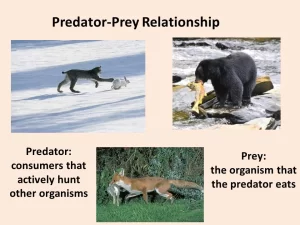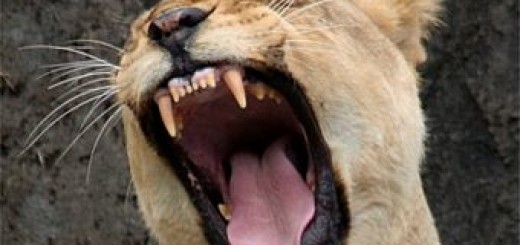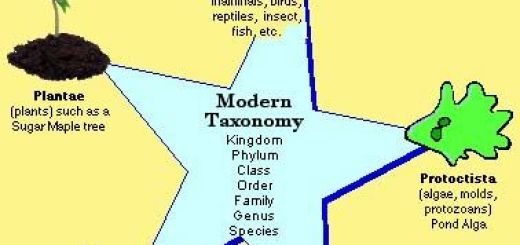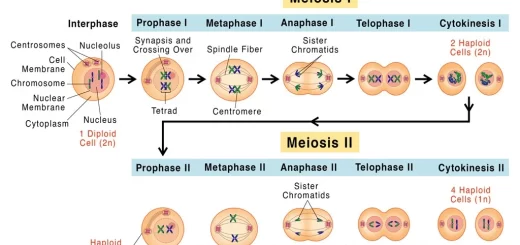Food relationships among living organisms (Predation, Symbiosis and Saprophytism)
Food is the main source of energy for all living organisms, where green plants make their food during the photosynthesis process from simple substances which are carbon dioxide gas, and water, Sunlight as a source of energy, So, green plants are called producers (autotrophic organisms).
Food relationships
Some animals depend on plants directly, so, these animals are called herbivorous such as rabbits, sheep ….etc., Some other animals depend on plants indirectly, so, these animals are called carnivorous such as lions, snakes…..etc. , so, there are many food relationships among living organisms.
Types of food relationships
The types of food relationships are Predation, Symbiosis, and Saprophytism.
Predation
Predation is a food relationship among living organisms, where one living organism devours another one, Predation occurs between two living organisms, The predator which devours the other living organisms, and the prey which is the devoured living organisms.
Predation is a temporary relationship, because it ends by devouring the prey or a part of it, where the predator attacks, kills, or devours the prey, Predation occurs in the plant world and animal world.
Predation in plants
Predation is less common in the plant world than in the animal world because plants can make their food (carbohydrates and protein) by the photosynthesis process, Some plants can not make protein, because they can not absorb some components from the soil.
So, they prey some tiny animals as insects to get their required elements for making protein and these plants are known as insect-eaters (insectivorous) plants, such as Drosera and Dionaea, Drosera is an insectivorous plant because it preys some insects to get the required elements for making protein.
Predation in animals
Predation in animals such as a lion preys a deer, a wolf preys a rabbit, and a cat preys a rat, Spiders, where they make woven to catch insects, So, Lions, tigers, spiders, wolves, cats, snakes, and sharks are considered as predator animals.
Some ways of self-defense against predation in living organisms
Many living organisms have (appeal to) different ways of defending themselves against enemies such as camouflage and mimicry.
Camouflage
Camouflage is a phenomenon in which living organisms protect themselves (hides) from enemies by changing their colour to simulate the colours of their surrounding environment, This phenomenon is found in fish, frogs, birds, chameleons, and most insects as butterflies.
Examples of Camouflage
- A butterfly stands on a tree with similar colours.
- A frog changes its colour to hide from its enemies.
- A chameleon simulates the colour of the surrounding environment to protect itself ( hide ) from its enemies.
- A cuttlefish (sepia) ejects a black fluid in the surrounding water to hide when attacked by enemies.
Mimicry
Mimicry is a phenomenon in which harmless living organisms imitate other harmful or poisonous living organisms to frighten their enemies and escape from them, such as some bees look like wasps in forming lines (stripes) on their bodies to frighten their enemies.
Some bees look like wasps in forming lines (stripes) on their bodies to frighten their enemies which get afraid of wasps and escape from them.
Symbiosis
Symbiosis is a common food relationship between two different living organisms, Types of symbiosis are mutualism, commensalism, and parasitism.
Mutualism
Mutualism is a food relationship in which each organism gets benefits (in the form of food) from the other, Such as the relationship between nodular bacteria and leguminous plants (as beans), Each of them gets benefit from the other in the form of food, where:
- Nodular bacteria fix nitrogen in an inorganic form to provide the plant with it.
- The plant provides bacteria with sugar made by the plant during the photosynthesis process.
Benefits of mutualism in the human body
Several kinds of bacteria coexist with man, where each of them benefits from the other as follows:
Human body benefits from bacteria as: Some types of bacteria live inside man’s intestine and change some food remains into vitamin (B), and some live on his skin and work on increasing the immunity of the skin against diseases infection, Bacteria benefit from man in the previous case as the human body provides bacteria with food and shelter.
Commensalism
Commensalism is a food relationship between two living organisms where, one of them benefits from the other, while the other neither gets benefit (in the form of food) nor is harmed.
Example: The relationship between sponge and tiny aquatic living organisms, Tiny aquatic living organisms get food and shelter from the canals and fissures that are found inside the sponge, while the sponge neither gets food (benefit) nor is harmed.
Parasitism
Parasitism is a food relationship between two different kinds of living organisms, where one benefits from the other and is known as the parasite, while the other is harmed and is known as the host, Parasitism causes weakness to the host but it does not kill it, The types of Parasitism are external parasitism and internal Parasitism.
External parasitism
In this type of parasitism: The parasite lives externally on the host’s body and feeds by sucking the blood of the host, A parasite conveys diseases to the host, such as mosquitoes, lice, fleas, bugs, ticks, jawless lamprey (that sucks fish’s blood).
Internal Parasitism
In this type of parasitism: The parasite lives internally inside the host’s body and shares the host its digested food or feeds on its cells and tissues, Such as Bilharzia worms, ascaris worms, tape worms, filaria worms, and liver worms.
Harms of parasitism
Parasites cause many diseases to man such as :
- Filaria worm causes elephantiasis disease.
- Mosquitoes cause malaria disease.
- Fleas can convey small pox disease to man.
- Bilharzia worms cause bilharziasis disease.
- Ascaris worms cause anaemia.
The death of the host is considered a loss to the parasite because the parasite will lose its source of food and shelter, Some dogs, cats, and birds which we have at home can be hurt by worms and some of these worms can infect human, To protect man and these living organisms, follow the proper way of cleaning and visit the veterinaries regularly to check them.
Saprophytism
Saprophytism is a food relationship in which saprophytes (decomposers) get their food by decomposing food remains or bodies of dead organisms, such as mushroom fungus, Bread mold fungus and Penecillium fungus that decomposes orange fruits.
Saprophytic organisms such as bread mold fungus get their food by decomposing the food remains (as moist bread) causing the dark green layer on bread.
Importance of Food relationships among living organisms
Food relationships among living organisms are critical for the health and functioning of ecosystems. Food relationships are the foundation of a healthy ecosystem. They ensure the transfer of energy, maintain balance in populations, and drive evolutionary adaptations. These intricate interactions create a web of life where all organisms play a crucial role.
Energy Transfer and Flow:
Predation: Predators acquire energy by consuming prey, transferring energy from one feeding level to the next in a food chain or web. This movement of energy keeps the ecosystem functioning.
Symbiosis: Many symbiotic relationships involve the transfer of energy and nutrients between organisms. For example, in a mutualistic symbiosis, like clownfish and anemones, one organism provides food or protection for the other, creating a cycle of exchange.
Saprophytism: Decomposers, like fungi and bacteria, break down dead organisms and waste products. This process releases nutrients back into the soil, making them available for plants (producers) to use, restarting the energy flow in the ecosystem.
Maintaining Balance:
Predation: Predators help control prey populations, preventing any one species from overgrazing or dominating the ecosystem. This maintains biodiversity and ensures a healthy balance within the food web.
Symbiosis: Many symbiotic relationships promote the overall health of the ecosystem. Some legumes have a symbiotic relationship with nitrogen-fixing bacteria, enriching the soil with nitrogen, a crucial nutrient for plant growth.
Saprophytism: By decomposing dead organic matter, Saprophytic organisms return nutrients to the soil, making them available for new plant growth. This process is essential for maintaining soil fertility and supporting future generations of organisms.
Evolution and Adaptation:
Predation: The constant threat of predation drives prey to evolve adaptations for defense, like camouflage or speed. Predators, in turn, need to develop better hunting strategies to catch their prey. This predator-prey interaction is a major driver of evolution.
Symbiosis: Symbiotic relationships can lead to co-evolution, where both organisms adapt and evolve traits that benefit the partnership. This can lead to increased specialization and diversification within species.
You can subscribe to Science Online on YouTube from this link: Science Online




